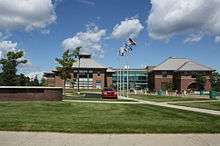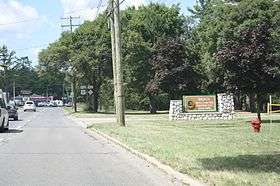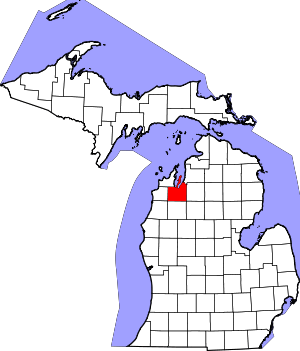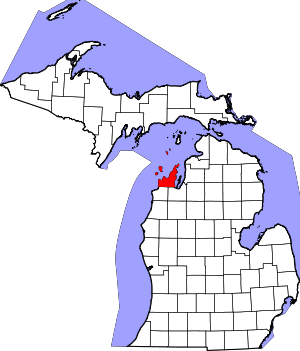Traverse City, Michigan
Traverse City (/ˈtrævərs ˈsɪti/ 'TRA-vurs-SI-tee' or locally /ˈtrævər.sɪti/ 'TRA-vur-si-tee') is a city in the U.S. state of Michigan. It is the county seat of Grand Traverse County,[6] although a small portion extends into Leelanau County. It is the largest city in the 21-county Northern Michigan region. The population was 14,674 at the 2010 census, with 143,372 in the Traverse City micropolitan area.
Traverse City, Michigan | |
|---|---|
City | |
| City of Traverse City | |
 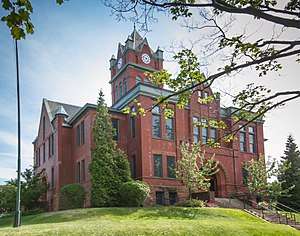 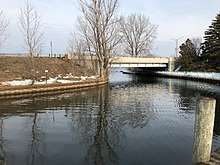 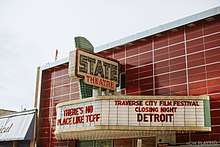 From left to right, top to bottom: Traverse City as seen from the Open Space; the former Traverse City State Hospital; the Boardman River flowing under the Murchie Bridge; the Grand Traverse County Courthouse; the State Theatre | |
 Flag  Logo | |
| Etymology: French: la grande traverse (the long crossing) | |
| Nickname(s): Traverse, "T.C.", The Cherry Capital (of the World), Cherryland, Queen City of the North, Coast Guard City | |
%2C_MI_location.png) Location within Leelanau County (top) and Grand Traverse County (bottom) | |
 Traverse City Location within the state of Michigan | |
| Coordinates: 44°46′05″N 85°37′20″W | |
| Country | United States |
| State | Michigan |
| Counties | Grand Traverse and Leelanau |
| Settled | June 13, 1847 |
| Incorporated | 1881 (village) May 18, 1895 (city) |
| Founded by | Perry Hannah, Albert Lay, Horace Boardman |
| Government | |
| • Type | Council–manager |
| • Mayor | Jim Carruthers[1] (D) |
| • City manager | Marty Colburn |
| Area | |
| • City | 8.66 sq mi (22.43 km2) |
| • Land | 8.33 sq mi (21.57 km2) |
| • Water | 0.34 sq mi (0.87 km2) |
| Elevation | 626 ft (191 m) |
| Population | |
| • City | 14,674 |
| • Estimate (2019)[4] | 15,738 |
| • Density | 1,890.22/sq mi (729.78/km2) |
| • Metro | 144,411 (Traverse City micropolitan area) |
| Time zone | UTC-5 (EST) |
| • Summer (DST) | UTC-4 (EDT) |
| ZIP code(s) | 49684, 49685, 49686, 49696 |
| Area code(s) | 231 |
| FIPS code | 26-80340 |
| GNIS feature ID | 1615042[5] |
| Website | www |
The Traverse City area is the largest producer of tart cherries in the United States, as of 2010.[7] Near the time of cherry harvest, the city hosts the annual week-long National Cherry Festival in the first full week of July, attracting approximately 500,000 visitors annually.[8] The surrounding countryside also produces grapes, and is one of the centers of wine production in the Midwest.[9] Tourism, both summer and winter, is another key industry. The Traverse City area features varied natural attractions, including freshwater beaches, vineyards, a National Lakeshore, downhill skiing areas, and numerous forests.[10] In 2009, TripAdvisor named Traverse City the number two small town travel destination in the United States.[11] In 2012, the city was listed among the 10 best places to retire in the country by U.S. News & World Report.[12]
History
19th century
Native Americans
Before European colonists and the Northwest Territory, Traverse City was occupied by the Ojibwe, Ottawa, and Potawatomi people. These people groups inhabited the area surrounding the Great Lakes, including Michigan. The Traverse City area was known to Natives as Kitchiwikwedongsing[13], which was often shortened to Wequetong, meaning "at the head of the bay", in reference to Grand Traverse Bay. The most recent Native American settlement, Wequetong, is located near what is now Clinch Park in downtown Traverse City. Over time, European settlers displaced the Natives, and their settlements at the head of Grand Traverse Bay were slowly abandoned.[14]
European-American settlement
After the colonists came in, they discovered the Grand Traverse Bay. The bay earned its name from 18th-century French voyageurs who made la grande traverse,[lower-alpha 1] or "the long crossing", across the mouth of bay, from present-day Norwood to Northport. The area was owned by the French, followed by Great Britain as the Province of Quebec. After 1776, the area was owned by the Americans.[16] On the Old Mission peninsula, Rev. Peter Doughtery started the first permanent settlement in 1839. This was called "Grand Traverse", and is today known as Old Mission.[17]
In 1847, Captain Horace Boardman of Naperville, Illinois, purchased the land at the mouth of the Boardman River (then known as the Ottawa River) at the head of the west arm of the bay, which at the time was still settled by Natives. During 1847, the captain, his son, and their employees built a dwelling and sawmill near the mouth of the river. In 1851 the Boardmans sold the sawmill to Hannah, Lay & Co (Perry Hannah, Albert Tracy Lay and James Morgan), who improved the mill greatly. The increased investment in the mill attracted additional settlers to the new community. Perry Hannah today is known as the founding father of Traverse City
Further growth
As of 1853, the only operating post office in the Grand Traverse Bay region was the one located at Old Mission, which was then known as "Grand Traverse". While in Washington, D.C. in 1852, Mr. Lay had succeeded in getting the U.S. Post Office to authorize a new post office at his newer settlement. As the newer settlement had become known as "Grand Traverse City", after the Grand Traverse Bay, Lay proposed this name for its post office, but the Post Office Department clerk suggested dropping the "Grand" from the name, as to limit confusion between this new office and the one at nearby Old Mission. Mr. Lay agreed to the new, shortened name of "Traverse City" for the post office, and the village took on this name. Also around this time, the first cherry trees were being planted on the Old Mission Peninsula, something the peninsula is widely known for today.
Railroads and incorporation
In December 1872, rail service arrived in Traverse City via a Traverse City Railroad Company spur from the Grand Rapids and Indiana Railroad line at Walton Junction[18]. The railroad tracked along the Boardman River and along Boardman Lake into Traverse City, and ended at a station along the Grand Traverse Bay, at the corner of present-day Grandview Parkway and Park Street. This new line of transportation from Southern Michigan opened up the area to settlement and industrial development. Many more people started flocking to the small community, and in 1881, Traverse City was incorporated as a village. This began the major commercial growth of the town.
In 1890, another rail line was extended to Traverse City, this one from Baldwin via Copemish and Interlochen[19]. This line primarily served lumber companies, such as the Buckley & Douglas Lumber Company, and was used to transport logs from the vast forest of Northwest Michigan to sawmills in Manistee and Traverse City. Two years later, new railroad were extended out of Traverse City[20]. One line was extended along the bay into Leelanau County, and curved south to a preexisting spur at Lake Ann. Another line was extended east into present-day Williamsburg, and to Charlevoix and Petoskey. This railroad was largely to serve tourists.
On May 18, 1895, Traverse City was incorporated as a city.
20th century
The first National Cherry Festival was held in Traverse City in 1925. It was first called "Blessing of the Blossoms" and held in the spring to attract people during the blooming season. With the exception of the years before and during World War II, this tradition has been carried on since in Traverse City. The legislature moved the date of the festival to the summer, and it attracts tourists from around the state. During the week the festival takes place, the population of Traverse City rises from about 15,000 to about 500,000. In 2004 the legislature added "Blossom Days", again as a spring festival.
In 1929, Traverse City's first airport, Ransom Field, opened, offering flights to Grand Rapids. It closed in 1936, when the new Traverse City Airport (now called Cherry Capital Airport) was opened. In 1953 the grounds of Ransom Field were redeveloped as Memorial Gardens Cemetery.
In 1934, the original Traverse City High School building burnt down, with no casualties. For three years, while the high school was being rebuilt, classes were moved to the Perry Hannah House, the former residence of the city's founder. Classes were moved back to the new school building in September of 1937[21]. In 1960, the high school was moved from downtown Traverse City to a new college-style campus on the grounds of Northwestern Michigan College, which opened a few years prior in 1951. The former high school building was converted to Traverse City Junior High. In 1997, the high school split into Traverse City Central and Traverse City West High Schools due to extreme overcrowding at the 1960s building[22].
Other retail and transportation changes, and new technology in the late 20th and early 21st centuries affected businesses. Two drive-in theaters in the vicinity (Sundowner Drive-In and Traverse Drive-In) closed, as well as three regular indoor theaters in the area. With this, the Cherryland Mall and Grand Traverse Mall opened in these years. In 1999, the interior of the Cherryland Mall was demolished, and the mall downgraded to an outdoor strip mall with anchor stores. As of 2020, the mall is largely vacant.
21st century
In 2005, Michigan filmmaker Michael Moore organized the first Traverse City Film Festival in downtown Traverse City.[23] In 2015 and 2016, Traverse City was called the best small town in America by Livability.com.[24]
On November 3, 2015, Traverse City elected Jim Carruthers,[25] its first openly gay mayor.[26]
May 18, 2020, served as the city's 125th anniversary of Traverse City's incorporation as a city in 1895, and was known as the "quarantine quasquicentennial".[13][27][28]
On June 1, 2020, commissioners of Traverse City approved a plan that would close two blocks of Front Street and return State Street to two-way traffic, until Labor Day of that year.[29] This was enacted in order to prevent crowding in reopening businesses following the COVID-19 pandemic.[30] This follows the canceling of the 2020 National Cherry Festival and Traverse City Film Festival.[31][32]
Geography
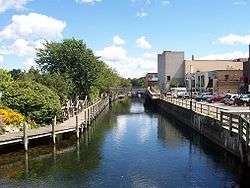
Topography
Traverse City is a part of the greater Northern Michigan region. The city is the main inland port of the Grand Traverse Bay—a long, natural harbor separated from the waters of Lake Michigan by the Leelanau Peninsula, and divided longitudinally almost evenly by a narrow peninsula of tiered hillsides and farmland called Old Mission Peninsula.
The most prominent of the city's waterways is the Boardman River. Along with Boardman Lake, the river is part of the Boardman River Watershed. The Boardman's 287-square-mile (740 km2) watershed contributes one-third of the water volume to the bay and is one of Michigan's top-ten fisheries, with more than 36 miles (58 km) of its 179 miles (288 km) designated as a Blue Ribbon trout fishery.[33] It is also a state-designated "Natural River".[34] Recently, a large project was finished on the Boardman, removing multiple dams from the course of the river.
According to the United States Census Bureau, the city has a total area of 8.66 square miles (22.43 km2), of which, 8.33 square miles (21.57 km2) of it is land and 0.33 square miles (0.85 km2) is water.[35]
.jpg)
Layout and cityscape
Traverse City, like most of Grand Traverse County and many other cities in the United States, is laid out in a grid plan. Major streets run east-west and north-south. North-south streets are named after people, trees, and geographical locations. East-west streets are named after numbers and people.
Traverse City has many fairly tall buildings for a small city. The tallest building is the Park Place Hotel (at 9 stories), although recently, many proposals have been made to build taller buildings. One of these was the River West building, which did not end up being built.
Traverse City has many beaches and public parks. A notable example is Clinch Park, a public park, beach, and splash pad. This park can be very congested during the summer months and especially during the National Cherry Festival.
Neighborhoods
- Airport
- Boardman
- Central
- Civic Center
- Incochee Hill
- Midtown
- NOBO (North Boardman)
- Oak Park
- Old Towne
- Orchard Park
- Slabtown
- Willow Hill
City parks
- American Legion Park
- Arbutus Court Park
- Ashton Park
- Boon Street Park
- Bryant Park
- Clancy Park
- Clinch Park
- Darrow Park
- Dutmers Natural Area
- East Bay Park
- F & M Park
- Fulton Park
- Grand Traverse County Civic Center
- Hickory Hills
- Highland Park
- Hickory Meadows
- Hull Park
- Indian Woods Park
- Jupiter Gardens
- Lay Park
- Meijer Silverbrook Acres
- Mini Park
- Open Space
- Senior Center Beach
- Slabtown Corner
- Sunrise Peace Park
- Sunset Park
- Union Street Dam Park
- Veterans Memorial Park
- West End Beach
Climate
Its location near the 45th parallel is tempered by the strong and moderating effects of Lake Michigan and Grand Traverse Bay, which have a particularly noteworthy effect on the peninsulas that branch north of the city. As a result, they have viticulture and cherry orchards.[38] Consequently, it generally experiences warm, mild summers and severe winters. Lake Michigan especially, but also Grand Traverse Bay, greatly impact the area's diverse coastal weather patterns, which occasionally consist of sudden and/or large amounts of precipitation during the seasonally active periods. Lake-effect snowfall constitutes a large percentage of the total annual snow accumulation, which averages around 80 inches (203 cm).[39] Periods of snowfall typically last from November to April, although light snow as late as May or as early as late September sometimes occur.
Traverse City's record high temperature is 105 °F (41 °C), recorded in 1936, and its low temperature is −33 °F (−36 °C), recorded on February 17, 1979.
| Climate data for Traverse City Airport, Michigan (1981-2010 normals, extremes 1896) | |||||||||||||
|---|---|---|---|---|---|---|---|---|---|---|---|---|---|
| Month | Jan | Feb | Mar | Apr | May | Jun | Jul | Aug | Sep | Oct | Nov | Dec | Year |
| Record high °F (°C) | 59 (15) |
65 (18) |
87 (31) |
90 (32) |
95 (35) |
104 (40) |
105 (41) |
100 (38) |
96 (36) |
89 (32) |
78 (26) |
64 (18) |
105 (41) |
| Average high °F (°C) | 28 (−2) |
30 (−1) |
40 (4) |
54 (12) |
66 (19) |
76 (24) |
80 (27) |
78 (26) |
70 (21) |
57 (14) |
44 (7) |
32 (0) |
55 (13) |
| Average low °F (°C) | 15 (−9) |
15 (−9) |
22 (−6) |
32 (0) |
42 (6) |
52 (11) |
58 (14) |
57 (14) |
50 (10) |
39 (4) |
30 (−1) |
21 (−6) |
36 (2) |
| Record low °F (°C) | −21 (−29) |
−37 (−38) |
−30 (−34) |
1 (−17) |
17 (−8) |
28 (−2) |
31 (−1) |
32 (0) |
26 (−3) |
15 (−9) |
−5 (−21) |
−26 (−32) |
−37 (−38) |
| Average precipitation inches (mm) | 2.82 (72) |
1.50 (38) |
1.86 (47) |
2.78 (71) |
2.59 (66) |
3.16 (80) |
3.02 (77) |
3.38 (86) |
3.53 (90) |
3.22 (82) |
2.70 (69) |
2.49 (63) |
33.05 (841) |
| Average snowfall inches (cm) | 23.1 (59) |
13.2 (34) |
8.2 (21) |
2.8 (7.1) |
0.1 (0.25) |
0 (0) |
0 (0) |
0 (0) |
0 (0) |
0.2 (0.51) |
7.2 (18) |
19.5 (50) |
74.3 (189.86) |
| Average precipitation days (≥ 0.01 in) | 17.0 | 12.3 | 11.4 | 10.9 | 10.4 | 9.7 | 8.5 | 9.9 | 12.0 | 13.1 | 14.6 | 16.0 | 145.8 |
| Average snowy days (≥ 0.1 in) | 12.6 | 8.9 | 5.6 | 2.3 | 0.1 | 0 | 0 | 0 | 0 | 0.3 | 4.8 | 11.7 | 46.3 |
| Source 1: NOAA [40] | |||||||||||||
| Source 2: NOAA NOWData [41] | |||||||||||||
Demographics
| Historical population | |||
|---|---|---|---|
| Census | Pop. | %± | |
| 1880 | 1,897 | — | |
| 1890 | 4,353 | 129.5% | |
| 1900 | 9,407 | 116.1% | |
| 1910 | 12,115 | 28.8% | |
| 1920 | 10,925 | −9.8% | |
| 1930 | 12,539 | 14.8% | |
| 1940 | 14,455 | 15.3% | |
| 1950 | 16,974 | 17.4% | |
| 1960 | 18,432 | 8.6% | |
| 1970 | 18,048 | −2.1% | |
| 1980 | 15,516 | −14.0% | |
| 1990 | 15,155 | −2.3% | |
| 2000 | 14,532 | −4.1% | |
| 2010 | 14,674 | 1.0% | |
| Est. 2019 | 15,738 | [4] | 7.3% |
| U.S. Decennial Census | |||
2010 census
As of the census[3] of 2010, there were 14,674 people, 6,675 households, and 3,369 families residing in the city. The population density was 1,761.6 inhabitants per square mile (680.2/km2). There were 7,358 housing units at an average density of 883.3 per square mile (341.0/km2). The racial makeup of the city was 94.4% White, 0.7% African American, 1.8% Native American, 0.7% Asian, 0.5% from other races, and 1.9% from two or more races. Hispanic or Latino of any race were 1.9% of the population.
There were 6,675 households, of which 22.3% had children under the age of 18 living with them, 35.6% were married couples living together, 10.9% had a female householder with no husband present, 4.0% had a male householder with no wife present, and 49.5% were non-families. 38.4% of all households were made up of individuals, and 13.3% had someone living alone who was 65 years of age or older. The average household size was 2.08 and the average family size was 2.77.
The median age in the city was 40.8 years. 18.2% of residents were under the age of 18; 10.3% were between the ages of 18 and 24; 26.7% were from 25 to 44; 28.3% were from 45 to 64; and 16.7% were 65 years of age or older. The gender makeup of the city was 47.4% male and 52.6% female.
2000 census
As of the census of 2000, there were 14,532 people, 6,443 households, and 3,485 families residing in the city. The population density was 1,728.7 per square mile (667.2/km2). There were 6,842 housing units at an average density of 813.9 per square mile (314.1/km2). The racial makeup of the city was 96.00% White, 0.65% African American, 0.98% Native American, 0.50% Asian, 0.03% Pacific Islander, 0.48% from other races, and 1.36% from two or more races. Hispanic or Latino of any race were 1.67% of the population.
There were 6,443 households, out of which 24.5% had children under the age of 18 living with them, 39.7% were married couples living together, 11.2% had a female householder with no husband present, and 45.9% were non-families. 35.9% of all households were made up of individuals, and 13.7% had someone living alone who was 65 years of age or older. The average household size was 2.15 and the average family size was 2.82.
In the city, the population was spread out, with 20.3% under the age of 18, 10.8% from 18 to 24, 29.6% from 25 to 44, 24.1% from 45 to 64, and 15.2% who were 65 years of age or older. The median age was 38 years. For every 100 females, there were 90.5 males. For every 100 females age 18 and over, there were 87.2 males.
The median income for a household in the city was $37,330, and the median income for a family was $46,912. Males had a median income of $31,587 versus $22,512 for females. The per capita income for the city was $22,247. About 4.8% of families and 8.4% of the population were below the poverty line, including 7.2% of those under age 18 and 7.9% of those age 65 or over.
Religion
Traverse City is part of the Roman Catholic Diocese of Gaylord.[42] It is part of the Episcopal Diocese of Western Michigan and served by Grace Episcopal Church.[43]
Government
Traverse City is a home rule, charter city under the Home Rule Cities Act, incorporated on May 18, 1895. The city is governed by six commissioners and a mayor, elected at-large. Together they comprise a seven-member legislative body. The commission appoints a city manager who serves as chief executive for city operations.
Education
Public schools
The main school district in Traverse City is the Traverse City Area Public Schools (TCAPS). The district currently has 12 elementary schools (including four within the city), two middle schools, three high schools (one within the city), one Montessori school (within the city).[44] Another school is The Woodland School, a public charter school in nearby Union Township.
Religious schools
Traverse City houses several religious schools, including St. Francis High School, Trinity Lutheran School, Immaculate Conception Elementary School, Traverse Bay Christian School, and Traverse Bay Mennonite School.
Private schools
Just outside of Traverse City is the Children's House, a private montessori academy.[45] Finally, there is the Pathfinder School in Greilickville, an independent school.[46]
Higher education
Traverse City is home to Northwestern Michigan College, a two-year community college.[47] Its annual enrollment is around 5,100. One of its campuses is at the Cherry Capital Airport, and offers aviation and auto service classes. Another campus is at the Hagerty Center on Grand Traverse Bay, which is home to Great Lakes Maritime Academy, Great Lakes Culinary Institute, Great Lakes Water Studies Institute, and the Hagerty Conference Center.
Libraries
Traverse City is served by the Traverse Area District Library, which has six branch libraries.[48]
Media
Print
The Traverse City Record-Eagle is one of northwest lower Michigan's daily newspapers. It is circulated in the 13 counties surrounding the city. In December 2006 it was sold by Ottaway Newspapers Inc., the community newspaper subsidiary of Dow Jones & Company to Community Newspaper Holdings, Inc. (CNHI). It is the newspaper of record for Grand Traverse County. Daily editions of the Detroit Free Press, The Detroit News, and The Grand Rapids Press also are available on news stands throughout the region. Other local publications have included Traverse (a monthly regional magazine), NM3 Magazine (a local lifestyle and entertainment publication, no longer published), Grand Traverse Insider (a local weekly community newspaper), Northern Express Weekly, Traverse City Business News, Edible Grande Traverse magazine dedicated to the food, farms and chefs of the area, and Grand Traverse Woman Magazine.
At least seven national magazines were published in Traverse City, including Thirdeye Magazine. Village Press is based in Traverse City; it publishes the Home Shop Machinist, Live Steam and Outdoor Railroading, Machinists' Workshop, Just Labs, Pointing Dog Journal, Retriever Journal and Twin and Turbine magazines.
Traverse City is also the home of Arbutus Press, one of the leading Michigan publishers for regional non-fiction. The company has published many books including four books selected by the Library of Michigan as Michigan Notable Books: Historic Cottages of Mackinac Island (awarded in 2002), Asylum for the Insane: History of Kalamazoo State Hospital (awarded in 2009), Vintage Views Along the West Michigan Pike (awarded in 2012), and Fishtown (awarded in 2013).
Television
Traverse City is the largest city in the Traverse City–Cadillac–Sault Ste. Marie designated market area, the largest television market in area east of the Mississippi River. Accordingly, most stations in this region are broadcast simultaneously on widely spaced transmitters on separate channels.
Traverse City has two television stations licensed directly to the city:
- Channel 7: WPBN-TV "TV 7&4" (NBC) (simulcast on channel 4, Cheboygan)
- Channel 29: WGTU "ABC 29&8" (ABC) (simulcast on channel 8, Goetzville)
Additionally, WGTU operated a CW Plus station on its second digital subchannel and Northern Michigan cable television systems:
- Channel 61: WGTU-DT2 "Northern Michigan's CW" (The CW). This is no longer in operation in Traverse City (as of June 2009)
The city also has a low power rebroadcast transmitter of Mount Pleasant's PBS affiliate, WCMU-TV, operating on channel 46 (W46AD).
Stations licensed to nearby Cadillac are considered local to Traverse City:
- Channel 9: WWTV "9 & 10 News" (CBS) (simulcast on channel 10, Goetzville in the eastern UP)
- Channel 32: WFQX-TV "Fox 32" (Fox)
Fox's sister network, MyNetworkTV, did not have an affiliate in the region when it launched back in September 2006. That changed at some point in 2008 when WLLZ-LP channel 12 (now WXII-LP) added the network.
Cable television service is provided within Traverse City and many outlying communities by Charter Communications. Public-access television cable TV programming is provided on channel 189.
Radio
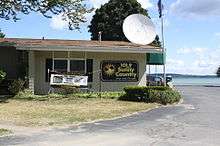
Traverse City is the home of Northern Michigan talk radio station WTCM News/Talk 580 AM. Other talk stations available in the Traverse City area include WJML, WMKT, WSRT, and WLDR. AM 1310 ESPN Radio (operated by WCCW) broadcasts national ESPN content along with Detroit Pistons, Tigers, Red Wings and Lions games. MSU Football and Basketball can also be heard on 1310.
There are 16 [49] commercial radio stations in a variety of radio formats. WKLT-97.5/98.9-FM is the area's longest serving rock station, known for its show Lunch at the Leetsville Cafe with Terri Ray, and the iconic Giant Red Radio party trailer. WNMC 90.7 FM is a community public radio station that is committed to a wide variety of musical genres and local events, with a broadcast focus on jazz, blues, and world music.
Traverse City has three religious radio stations: W201CM (a translator at 88.1) and WLJN AM/FM 89.9 FM and 1400 AM. In 2014 WLJN added another frequency at 95.9 playing contemporary Christian music 24 hours a day.
Interlochen Center for the Arts broadcasts the NPR member station dubbed Interlochen Public Radio.[50] it serves a large portion of Northwest Lower Michigan via two stations:[51] 88.7 is music and 91.5 is talk.
WLDR was for 10 years Sunny Country 101.9 until October 22, 2014, when the station switched back to an adult contemporary format. The station went on the air in 1966 with owner Roderick Maxson serving the Grand Traverse area and surrounding counties. They were the first to broadcast in HD radio in Michigan. They have been the sponsor for several major events in Traverse City, including The Beach Bum Games, Horses by the Bay, the Make-A-Wish Motorcycle Tour, and the Traverse City Easter Egg Hunt.
Culture
Most of Traverse City's economy is based on tourism.[52] As part of the 2011 tourism advertising campaign the Traverse City Visitors Bureau, Traverse City Cherry Capital Airport and local businesses sponsored a video to be played on all Delta flights in the month of June 2011.[53] The National Cherry Festival, usually in the first week of July, tends to host hundreds of thousands of tourists and locals to the area, as does the Traverse City Film Festival (established in 2005) at the end of July. It has become a focal point within the craft brewing trend. In November Beer Week is celebrated, with tours of breweries including samplings of craft brews, dinners and workshops.[54]
The National Cherry Festival, held during the first full week of July every year, is a draw for tourists to Traverse City. The festival features parades, fireworks, an air show, election of festival royalty, live music, a pie-eating contest and cherries. It is estimated that the Grand Traverse region produces up to 360,000,000 pounds (163,000,000 kg) of cherries annually. The largest variety of cherry produced locally is the Montmorency cherry, or the "pie cherry". Other cherries grown in the region include the Ulster, or sweet cherry, and the Balaton (from Lake Balaton in Hungary), a cherry situated between the Montmorency and Ulster in terms of color and taste.
The Traverse City Film Festival, held at the end of July and beginning of August every year since 2005, is another draw for tourists and film buffs to Traverse City. It was started by Michael Moore, Doug Stanton and John Robert Williams as a way to bring more culture into the area via cinema.
The locale and topography is conducive for road bicycling, aided by the TART trail system.[55] A map with routes, different trips, advice and local knowledge is available.[56] Lake Michigan presents a location for sailing, fishing, and kayaking.[57]
The Traverse City State Park, with about 250 campsites, is located three miles (4.8 km) east of downtown on 47 acres (19 ha) including a quarter mile beach on the East Bay arm of Grand Traverse Bay.
The Boardman River Nature Center is the interpretive center and management headquarters for the Grand Traverse Natural Education Reserve, a 505-acre local park and natural area.
The sandy soil is conducive to viticulture, and there are over 50 wineries in the Traverse City area.[58] Most offer free wine tasting. Traverse city is located at the base of the Old Mission Peninsula wine region.
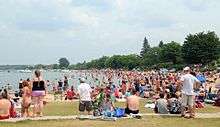
Performing arts and exhibits
The City Opera House, located in downtown Traverse City features plays, movies, and other performances.
The Traverse Symphony Orchestra (TSO), founded in 1952 by community leader Elnora Milliken as the Northwestern Michigan Symphony Orchestra, has grown from a small group of volunteer musicians to a paid professional orchestra of 60 contracted members. There was a connection over the years with Interlochen Center for the Arts, providing a core of musicians and conductors from among faculty and students. Until 1985 it was known as the Northwestern Michigan Symphony Orchestra.[59]
The Dennos Museum Center, located on the campus of Northwestern Michigan College, is home to a collection of Inuit art including sculpture, drawing and prints. The center is also home to an interactive gallery, as well as various ongoing exhibitions in their large exhibition space. The museum expanded in 2017 and added two new wings of galleries to display art from its permanent collection (both of Inuit art and non-Inuit art).[60]
Historical markers
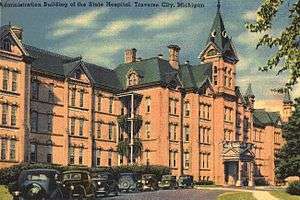
There are eleven recognized Michigan historical markers in the Traverse City area.[61] They are:
- Bingham District No. 5 Schoolhouse
- City Opera House
- Congregation Beth El
- Grand Traverse Bay
- Grand Traverse County Courthouse
- Great Lakes Sport Fishery
- Ladies Library Association
- Novotny's Saloon
- Park Place Hotel
- Perry Hannah House
- Traverse City State Hospital
Surrounding wineries
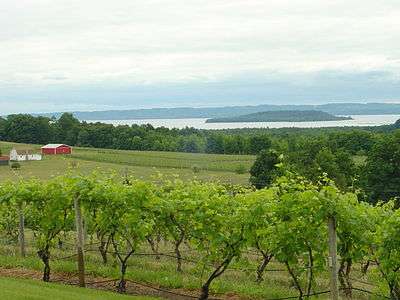
Traverse City was named by USA Today among the Top Ten Places for Local Wine.[62] There are nine wineries on the Old Mission Peninsula and 21 wineries on the Leelanau Peninsula,[63] both just a few minutes drive from downtown Traverse City. Both peninsulas sit close to the 45th parallel, a latitude known for growing prestigious grapes. The two arms of Grand Traverse Bay provide the ideal maritime climate and the rich glacial soil does the rest. Northern Michigan specializes in growing white grapes and is known for its Rieslings which grow well in the summer months and late fall which Traverse City is known for. Every October the wineries host a harvest fest. Some Riesling grapes are spared being picked in the fall to be picked when they freeze, from which ice wine is made. The wineries along the Old Mission Peninsula are Black Star Farms, 2 Lads Winery, Bowers Harbor Vineyards, Brys Estate Vineyard & Winery, Chateau Chantal Winery And Inn, Chateau Grand Traverse, Bonobo Winery, Mari Vineyards, and Peninsula Cellars. The wineries along the Leelanau Peninsula are Black Star Farms, Leelenau Cellars, Silver Leaf Vineyard and Winery, Gill's Pier Vineyard and Winery, Raftshol Vineyards, Circa Estate Winery, Forty-Five North Vineyard and Winery, Good Harbor Vineyards, Chateau Fontaine, Boskydel Vineyards, L. Mawby Vineyards, Ciccone Vineyard and Winery, Willow Vineyards, Chateau de Leelanau Vineyard and Winery, Shady Lane Cellars, Cherry Republic Winery, Longview Winery, Boathouse Winery, Verterra, Brengman Brothers, Bel Lago Winery, and Rove Estate Vineyard and Winery.[63][64]
Sports
Traverse City is home to many public sporting facilities. These include the Grand Traverse County Civic Center, which is a large sports complex in the heart of the city, housing seven baseball/softball fields, a skatepark, a mile-long walk trail, an amphitheater, sledding hill, pavilion, playground, an indoor pool, and an indoor hockey rink.[65] Other complexes include the Grand Traverse Bay YMCA, four complexes that offer public swimming, soccer, and tennis.[66] Many of the city parks in Traverse City also offer volleyball, soccer, and basketball.
| Club | Sport | League | Venue | Founded | Reference |
|---|---|---|---|---|---|
| Traverse City Pit Spitters | Baseball | Northwoods League | Turtle Creek Stadium | 2019 | [67][68] |
| Traverse City Cohos | Hockey | Midwest Junior Hockey League | Centre Ice/Huntington Rink | 2012 | [69] |
| Traverse City Wolves | Football | Great Lakes Football Conference | Thirlby Field | 2007 | [70] |
Economy
Traverse City is home to a number of local businesses including Hagerty Insurance Agency and Munson Medical Center. There is a significant manufacturing presence, as well.[71] In recent years, the city has developed a growing technology industry, with numerous tech start-ups, a startup incubator,[72] podcasts, and breweries. Traverse City and its micropolitan area are known for their small business, which bring in a multitude of people during the summer months.
| Rank | Employer | Industry |
|---|---|---|
| 1 | Munson Medical Center | Healthcare |
| 2 | Traverse City Area Public Schools | Education |
| 3 | Northwestern Michigan College | Education |
| 4 | Traverse Bay Area Intermediate School District | Education |
| 5 | Grand Traverse Resort & Spa | Entertainment |
| 6 | Interlochen Center for the Arts | Education |
| 7 | County of Grand Traverse | Government |
| 8 | Grand Traverse Pavilions | Healthcare |
| 9 | Tyson Foods | Food Processing |
| 10 | Hagerty Insurance Agency | Insurance |
Traverse City's central business district is located along Front Street downtown. Another major shopping district is on US 31 southwest of town, where several big box stores are located, as well as a shopping malls, the Grand Traverse Mall, anchored by Target, JCPenney, Macy's. The Buffalo Ridge Shopping Center is also on US 31 about a mile northwest of the Grand Traverse Mall. Another mall, the Cherryland Center, is located on Garfield Avenue on the south end of town; this mall features Big Lots. Two Meijer stores, one Walmart, one Sam's Club, one Costco, one Target, one Menards, and a multitude of local grocery store chains offer grocery and other options to big-box shopping.
Transportation
Airports
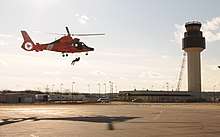
With a new terminal completed in 2004, Cherry Capital Airport provides regularly scheduled passenger airline service to Chicago and Detroit, with seasonal flights to Dallas-Fort Worth, Minneapolis-Saint Paul, Atlanta, New York City, Denver, and Newark. It is the fourth largest airport in Michigan. Around the area, there are smaller nearby paved and unpaved airports.
Ships and boats
- Adjacent to the airport is Coast Guard Air Station Traverse City, responsible for both maritime and land-based search and rescue operations in the northern Great Lakes region. On April 7, 2010, the USCG designated Traverse City a Coast Guard City. Traverse City is the second city in Michigan and tenth in the country to receive this honor.[74]
- Located in the harbor of the Great Lakes Maritime Academy is the T/S State of Michigan, a 224-foot (68 m) former Navy submarine surveillance vessel. The vessel is used as a classroom and laboratory while cadets of the Academy are underway and shore side.
- A tall ship, the schooner Manitou is berthed at Traverse City, and offers passages to the public.[75]
- Near Traverse City are two other tall ships, the schooner Madeline and the 55-foot (17 m) long replica of the sloop Welcome, an 18th-century British warship sloop, which was built for the 1976 Bicentennial of the American Revolution. They are the only two boats recognized by the State of Michigan for their historic significance. From May through October, trained volunteers conduct tours (when in port), and give a history of the boats and Great Lakes sailing. The Madeline is berthed at Elmwood Township "Coal Dock" (Heritage Harbor), West Bayshore, just south of the Elmwood Township Marina[76] Both are maintained by the Maritime Heritage Alliance.[77][78]
- The Nauti-Cat, a 43-passenger catamaran books passages on Grand Traverse bay. The Nauti-Cat is the largest commercial sailing catamaran on the Great Lakes at 47-foot (14 m) long, 29-foot (8.8 m) wide and has a 63-foot (19 m) mast. They offer cruises 7 days a week, 4 times a day.[79]
Buses
The area is served by Indian Trails Bus service, an intercity bus system that connects to St. Ignace to the north and to Grand Rapids and Kalamazoo to the south. The bus station is located at 107 Hall Street with connection to the BATA transfer station.
Traverse City also has a public transportation system, the Bay Area Transportation Authority (BATA) which serves most of the Grand Traverse and Leelanau region. With link services and a fixed route bus service, called the Loops,[80] serves Traverse City and the urbanized areas of Garfield Township. BATA put into service its first hybrid bus in December 2005. BATA's downtown bus transfer terminal on Hall Street opened July 21, 2006. The terminal is used to transfer riders to different buses on different routes.
Major highways
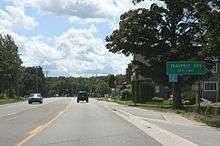




Railroads
The Great Lakes Central Railroad (GLCR) provides freight rail service to the Traverse City area on track owned by the state of Michigan. The tracks were once owned by the Chesapeake and Ohio Railway (ex-Pere Marquette Railway) and the Pennsylvania Railroad (ex-Grand Rapids and Indiana Railroad) but were purchased by the state in the late 1970s and early 1980s to preserve rail service in the area. Current freight traffic includes fruit/perishables, scrap metal, and lumber.
Regular intercity passenger train service ended on October 29, 1966, after the Chesapeake and Ohio Railway (C&O) discontinued Grand Rapids–Traverse City–Bay View service. Since then, excursion passengers trains have operated in and out of Traverse City on an irregular basis. Recently, Lake Central Rail Tours has operated a summer excursion during the Cherry Festival until 2008. On May 11, 1996, the Grand Traverse Dinner Train began year round service from the Traverse City depot to Williamsburg and to Walton Junction. Dinner train service was suspended in 2004 after a contract dispute with the Tuscola and Saginaw Bay Railway and additional difficulties. The train itself was removed to Owosso in mid-July 2006.[81][82] However, in 2015 a study was started by the Michigan Department of Transportation, and passenger rail is gaining interest.[83]
Accolades
- Greatest Midwest Town, Midwest Living
- Top 100 Best Small Towns, Livability.com
- 25 Best Small US Cities to Spend the Weekend, Thrillist
- Top 20 Small Towns to Visit, Smithsonian.com
- Must See American Cities, Horizon Travel Magazine
- Destination on the Rise, TripAdvisor
- Up-and-Coming Food City, Condé Nast Traveler
- 14 Best Beach Towns in America, Thrillist
- One of 5 Midwestern Small Towns to Visit Now, Fodor's
- One of 7 Top Wine Regions to Watch, Touring & Tasting
- One of America's Favorite Towns, Travel + Leisure
- America's Most Scenic Waterside Drives, Travel + Leisure
- Michigan's Three Best Beach Towns, Coastal Living
- Top 10 Things for Families to Do in Michigan, Trekaroo.com
- Top 7 Beer Destinations in North America, The Travel Channel
- One of America's five top foodie towns, Bon Appétit
- Sleeping Bear Dunes National Lakeshore: "The Most Beautiful Place in America", Good Morning America Viewers
- Top Midwest Travel Spots, TripAdvisor
- Top 10 Places to Enjoy Local Wines, USA Today
- One of 3 Emerging Beer Towns, Draft Magazine
- 25 Coolest Midwest Vacation Spots, Midwest Living
- Ten Great Boating Towns, BoatUS Magazine
- Top 10 Beach Towns in America, AOL Travel News
In popular culture
- The Dogman story takes place in and around the Traverse City area, primarily in Wexford County, to the south. In 2012, the Dogman movie, which takes place in nearby Benzie County, was released at the State Theater on Front Street. A sequel known as Dogman: The Wrath of the Litter was released in 2014. Both were filmed on the Old Mission Peninsula[86][87]
- Most of the Aaron Stander mystery novels take place in Northern Michigan, including Traverse City[88]
- The novel Station Eleven by Emily St. John Mandel takes place in a post-apocalyptic Michigan, with some locations in the Traverse City area.[89]
- Most of the movies made in the Traverse City Film Festival take place in and around Northern Michigan.
- The short film Camp Manna was filmed at the girl's YMCA Camp Arbutus Hayo-Went-Ha[90]
- "Unruhe", a season 4 episode of The X-Files, takes place in Traverse City.[91]
- Traverse City is mentioned in Bryan Gruley's Starvation Lake.
- A Season 5 episode of Trading Spaces, featuring Traverse City native Carter Oosterhouse, is set on Wadsworth Street.[92] Oosterhouse is handed the key to the city by former mayor Linda Smyka.
- The Curse of Oak Island follows Traverse City residents Rick and Marty Lagina, and often takes place at Marty Lagina's office on Front Street[93][94]. The brothers also own and operate Villa Mari Vineyards on Old Mission Peninsula.[95]
Notable people
- Martha E. Cram Bates (1839–1905), writer, journalist, newspaper editor
- Kate Botello, host of TechTV's The Screen Savers and Extended Play, resides in Traverse City, where she owns a web design company
- Mark Brammer, Michigan State University football player, All-America 1978, later played for the NFL's Buffalo Bills
- Demas T. Craw, posthumous Medal of Honor winner
- Jeremy Davies, actor, featured in Saving Private Ryan, Solaris, Lost, CQ and Justified
- Dallas Drake, NHL player who last played for the Detroit Red Wings; previously with Winnipeg Jets/Phoenix Coyotes, and St. Louis Blues
- Robert P. Griffin, Justice of the Michigan Supreme Court from 1987 to 1994; United States Senator from 1966 to 1979; U.S. Representative from 1957 to 1966; the Grand Traverse County Robert P. Griffin Hall of Justice was dedicated in his honor on November 13, 2006
- Walter Hagen, professional golfer, lived in Traverse City from 1958 to 1969
- Pearl M. Hart, pioneering Chicago attorney
- Gary Hogeboom, NFL player for the Dallas Cowboys, Indianapolis Colts, Phoenix Cardinals, and Washington Redskins; played for Central Michigan University and Northview High School in Grand Rapids
- Gordie Howe, legendary hockey player, played for Detroit Red Wings and lived in Traverse City from the late 1980s to 1999
- Bob James, jazz musician, created instrumental theme song for TV sitcom Taxi, sampled by numerous hip-hop artists; resident of Traverse City
- Tom Kozelko, NBA basketball player with the Washington Bullets
- Angus MacLellan, professional rugby player with the United States national rugby union team
- Dan Majerle, NBA basketball player who played for the Phoenix Suns, Miami Heat and Cleveland Cavaliers
- Mike Matteucci, NHL player for the Minnesota Wild
- Barbara McGuire, polymer clay artist and author
- Suzy Merchant, coach for Michigan State University women's basketball team
- William G. Milliken, Republican Governor of Michigan from 1969 to 1983
- Doug Mirabelli, MLB player for the Boston Red Sox, San Diego Padres, Texas Rangers and the San Francisco Giants
- Michael Moore, filmmaker, local resident, supporter of the renovation of the State Theatre and Traverse City Film Festival[96][97][98][99]
- Matt Noveskey, musician in the bands Blue October and (a+) machines
- Bunny Oakes, head football coach at the University of Colorado at Boulder from 1935 to 1939, compiled a 25-15-1 (.622) record
- Carter Oosterhouse, carpenter on reality TV show Trading Spaces
- John T. Parsons, pioneered numerical control for machine tools in the 1940s
- Pat Paulsen, actor, comedian, political candidate, co-owner of Cherry County Playhouse theater during the 1970s
- Lawrence Plamondon, 1960s activist
- Zach Redmond, NHL player for Winnipeg Jets, team captain at Ferris State
- Brian Rolston, NHL player for the New Jersey Devils, Colorado Avalanche, Boston Bruins, Minnesota Wild and New York Islanders
- Wilson Sawyer, composer and musician
- Mel Schacher, bassist for Grand Funk Railroad[100]
- John Scott, 2016 NHL All-Star MVP[101]
- Bernice Steadman, aviator and member of the Mercury 13[102]
- The Accidentals, Indie folk band formed in Traverse City
- Craig Thompson, cartoonist and graphic novelist, best known for Blankets
- Barry Watson, actor, known for TV series 7th Heaven and Samantha Who?
- David Wayne, film, television and Tony Award-winning stage actor, Adam's Rib, The Tender Trap, The Andromeda Strain, Ellery Queen, Batman
- Ezra Winter, muralist
- Jon Tuck, entrepreneur and philanthropist
See also
- Cherry production in Michigan
- Former Traverse City State Hospital, historical Kirkbride Building
- Munson Medical Center, regional medical referral center serving patients from 32 counties in Northern Michigan and the Upper Peninsula
- Watershed Center Grand Traverse Bay
Notes
- In modern standard French, traverse no longer has the sense of 'crossing'—which is now traversée.[15]
References
Footnotes
- Merlin, Michelle; McGillivary, Brian (November 4, 2015). "Carruthers Wins City Election". Traverse City Record-Eagle. Retrieved November 21, 2015.
- "2019 U.S. Gazetteer Files". United States Census Bureau. Retrieved July 25, 2020.
- "U.S. Census website". United States Census Bureau. Retrieved November 25, 2012.
- "Population and Housing Unit Estimates". United States Census Bureau. May 24, 2020. Retrieved May 27, 2020.
- "US Board on Geographic Names". United States Geological Survey. October 25, 2007. Retrieved January 31, 2008.
- "Find a County". National Association of Counties. Archived from the original on May 31, 2011. Retrieved June 7, 2011.
- "Cherry Production" (PDF). National Agricultural Statistics Service. June 17, 2010. Archived from the original (PDF) on June 22, 2011. Retrieved October 28, 2010.
- "National Cherry Festival". Local Legacies: Celebrating Community Roots. Library of Congress. Retrieved October 28, 2010.
- "Traverse City Wineries". Michigan Economic Development Corporation. Retrieved October 28, 2010.
- "Things to Do in Traverse City". TripAdvisor. Retrieved October 28, 2010.
- "Top 10 Charming Small Towns". Milwaukee Journal Sentinel. June 19, 2010. Retrieved October 28, 2010.
- Brandon, Emily. "The 10 Best Places to Retire in 2012". U.S. News & World Report. Archived from the original on October 16, 2015.
- Travis, Jordan; Clark, Sierra (May 16, 2020). "Traverse City Marks 125 Years Since Incorporation as City with Virtual, Dispersed Activities". Traverse City Record-Eagle. Retrieved May 18, 2020.
- Vogel, Virgil J. (1986). Indian Names in Michigan. Ann Arbor: University of Michigan Press. ISBN 0472063650.
- "traverse" (in French). Centre national de ressources textuelles.
- "Grand Traverse Bay". Michigan Historical Markers. Retrieved October 28, 2010.
- Norton, Mike (April 15, 2014). "Exploring the Past in Historic Traverse City".
- "Am I Emo?". Quizony. Retrieved June 2, 2020.
- "michiganrailroads.com - Evolution Map - Lower - 1890". www.michiganrailroads.com. Retrieved June 2, 2020.
- "michiganrailroads.com - Evolution Map - Lower - 1892". www.michiganrailroads.com. Retrieved June 2, 2020.
- "Looking Back On Education History In Traverse City". The Ticker | Traverse City News & Events. Retrieved June 2, 2020.
- "Looking Back On Education History In Traverse City". The Ticker | Traverse City News & Events. Retrieved June 2, 2020.
- "About the Traverse City Film Festival". Traverse City Film Festival. Retrieved May 10, 2018.
- "Traverse City Accolades". Retrieved May 10, 2018.
- Merlin, Michelle; McGillivary, Brian (November 4, 2015). "Carruthers wins city election: Lewis, Haas, Shamroe win commission seats". Traverse City Record-Eagle. Retrieved June 24, 2020.
- Selbig, Aaron (December 2, 2015). "Press 'pause' on Pine Street development, says mayor". Interlochen Public Radio. Retrieved June 24, 2020.
- "Traverse City's 125th Birthday: A Virtual Celebration". City of Traverse City. Retrieved May 18, 2020.
- "Traverse City is Turning 125! Here's How to Celebrate at Home". MyNorth.com. May 13, 2020. Retrieved May 18, 2020.
- "TC Commission Approves Front Street Closure Plan". The Ticker | Traverse City News & Events. Retrieved June 3, 2020.
- Jackson, Angie. "Traverse City eyes closing Front Street downtown to cars as businesses plan to reopen". Detroit Free Press. Retrieved June 3, 2020.
- "TC Film Festival Cancels 2020 Event". The Ticker | Traverse City News & Events. Retrieved June 3, 2020.
- "National Cherry Festival canceled for 2020". mlive. April 16, 2020. Retrieved June 3, 2020.
- "Boardman River". Boardman River Dams Committee. Retrieved July 14, 2014.
- "The River". The Boardman River Dams Project. Boardman River Dams Committee. Retrieved October 28, 2010.
- "US Gazetteer Files 2010". United States Census Bureau. Archived from the original on February 20, 2011. Retrieved November 25, 2012.
- "Neighborhood Associations | City of Traverse City". www.traversecitymi.gov. Retrieved November 6, 2017.
- "ArcGIS Web Application". tcgis.traversecitymi.gov. Retrieved June 10, 2020.
- "Traverse City Climate Narrative". Antrim County: Michigan State Climatologist's Office. Archived from the original on July 18, 2011. Retrieved December 10, 2010.
- "Gaylord, MI Weather Forecast Office". National Weather Service. Retrieved October 28, 2010.
- "NOWData: NOAA Online Weather Data". National Weather Service. Retrieved August 16, 2012.
- "Record Highs and Lows". Retrieved September 23, 2016.
- Diocese of Gaylord. Counties & Vicariate Maps (Map). Diocese of Gaylord. Archived from the original on October 10, 2010. Retrieved October 28, 2010.
- "Grace Episcopal Church, Traverse City, MI". Episcopal Church. June 13, 2011. Archived from the original on October 11, 2015. Retrieved August 17, 2019.
- "Schools". www.tcaps.net. Retrieved January 8, 2018.
- "The Children's House, An Independent Montessori School". traversechildrenshouse.org. Retrieved January 8, 2018.
- "Pathfinder School: Independent Day School, Traverse City, Michigan : Pathfinder School". thepathfinderschool.org. Retrieved January 8, 2018.
- "NMC : Northwestern Michigan College". nmc.edu. Retrieved January 8, 2018.
- "Traverse Area District Library". tadl.org. Retrieved January 8, 2018.
- "Commercial Radio Stations in Traverse City, MI". Retrieved April 9, 2009.
- "NPR Stations in Traverse City, MI". Find a Station. NPR. Retrieved March 27, 2006.
- "Coverage Area". Interlochen Public Radio. Archived from the original on March 11, 2007. Retrieved March 27, 2006.
- "Tourism in Traverse City". Michigan History.
- "theticker.tc". theticker.tc. Archived from the original on February 4, 2016.
- "Traverse City Beer Week". Retrieved October 27, 2015.
- Mansnerus, Laura (June 6, 1993). "Bicycling in Western Michigan". The New York Times. p. 3. Retrieved May 26, 2010.
- Club Map (Map). Cherry Capital Cycling Club. Archived from the original on April 13, 2010. Retrieved October 28, 2010.
- "Old Mission Peninsula: Traverse City Michigan Sea Kayak Tours". Trails.com. Archived from the original on January 5, 2013. Retrieved October 28, 2010.
- "Michigan Wineries and Vineyards: Winery Tours and Tastings". Pure Michigan. Michigan Economic Development Corporation.
- Flesher, John (February 28, 2014). "Traverse Symphony Orchestra Conductor Kevin Rhodes". MyNorth.com. Retrieved March 14, 2016.
- "Dennos Museum Expansion Means New Space, New Exhibits, New Performers". MyNorth.com. September 25, 2017.
- "Grand Traverse County". Michigan Historical Markers. Archived from the original on June 6, 2011. Retrieved October 28, 2010.
- "10 Great Places For Local Wines". USA Today. January 10, 2011.
- "Michigan Wines : Maps : Winery Tour Map : Northwest Region". Archived from the original on December 28, 2012.
- "Rove Estate". Leelanau Peninsula Wine Trail. Retrieved November 29, 2017.
- "Grand Traverse County Civic Center".
- "Grand Traverse Bay YMCA". Grand Traverse Bay YMCA. Retrieved February 14, 2018.
- "Introducing the Traverse City Pit Spitters!". PitSpitters.com. January 29, 2019. Retrieved January 29, 2019.
- Herringa, Katie (January 29, 2019). "Traverse City Baseball Announces New Team Name". MISportsNow.com. Retrieved January 29, 2019.
- "TC Cohos take the ice". UpNorthLive. Traverse City, MI: WPBN-TV. Retrieved February 14, 2018.
- "Traverse City Wolves". Traverse City Wolves. Retrieved February 14, 2018.
- "Information". Grand Traverse Area Manufacturing Council. Archived from the original on August 17, 2019. Retrieved August 17, 2019.
- "20Fathoms Tech Incubator Home to 20 Startups, and Growing". MyNorth.com. January 22, 2019. Archived from the original on February 3, 2019. Retrieved August 17, 2019.
- "Major Employers: Northern Nexus". www.northernnexus.org. Retrieved February 14, 2018.
- "Coast Guard Cities". United States Coast Guard. April 7, 2010. Retrieved October 28, 2010.
- "Tall Ship Manitou". Traverse Tall Ship Co. Archived from the original on October 24, 2010. Retrieved October 28, 2010.
- "Greilickville: Elmwood Township Marina". Michigan Department of Natural Resources. May 14, 2009. Retrieved October 28, 2010.
- "Schooner Madeline". Maritime Heritage Alliance. Archived from the original on December 9, 2010. Retrieved October 28, 2010.
- "Armed Sloop HMAS Welcome". Maritime Heritage Alliance. Archived from the original on August 24, 2010. Retrieved October 28, 2010.
- "Welcome to Nauti-Cat Cruises". Nauti-Cat Cruises. Retrieved October 28, 2010.
- "Bay Area Transportation Authority". Bay Area Transportation Authority. Retrieved June 13, 2015.
- "The Grand Traverse Dinner Train Moves To Owosso Michigan | Amber Cyman Real Estate". Retrieved February 3, 2020.
- "Bells & Whistles: Trains Return To Traverse City". The Ticker | Traverse City News & Events. Retrieved February 3, 2020.
- Slagter, Martin (August 1, 2016). "Ann Arbor to Traverse City Rail Study Explores Costs, Demand for Service". MLive. Retrieved December 27, 2016.
- Detroit, Consulate-General of Japan in. "Sister Cities and States | Consulate-General of Japan in Detroit". www.detroit.us.emb-japan.go.jp (in Japanese). Retrieved October 26, 2017.
- "Accolades | Traverse City, MI". www.traversecity.com. Retrieved October 26, 2017.
- Brauer, Richard; Campbell, Larry Joe; Mayberry, Mariann; Guerrero, Kimberly (November 6, 2012). "Dogman". IMDb. Retrieved October 27, 2017.
- Brauer, Richard; Campbell, Larry Joe; Mayberry, Mariann; Guerrero, Kimberly (October 31, 2014). "Dogman 2: The Wrath of the Litter". Retrieved October 27, 2017.
- "Home". aaronstander.businesscatalyst.com. Retrieved October 27, 2017.
- Staff, Stateside. "Fiction Novel Station Eleven Set in Northern Michigan Is the 2015–16 Great Michigan Read Winner". Michigan Public Radio. Retrieved October 27, 2017.
- Drahos, Marta Hepler. "Local Set, Actors Featured in Camp Manna Film". Traverse City Record-Eagle. Retrieved October 27, 2017.
- Bowman, Rob (October 27, 1996), Unruhe, David Duchovny, Gillian Anderson, Pruitt Taylor Vince, retrieved April 12, 2018
- TV.com. "Trading Spaces: Traverse City: Wadsworth Street". TV.com. Retrieved December 3, 2019.
- Quinn, Jessie; Articles, More; December 04, 2018 (December 4, 2018). "What Is Marty Lagina's Job? How 'The Curse of Oak Island' Star Made His Fortune". Showbiz Cheat Sheet. Retrieved December 3, 2019.CS1 maint: numeric names: authors list (link)
- mdrahos@record-eagle.com, MARTA HEPLER DRAHOS. "Tragedy strikes TC, 'Oak' Island show". Traverse City Record-Eagle. Retrieved December 3, 2019.
- hostmaster (December 29, 2016). "Villa Mari Vineyards". Michigan. Retrieved December 3, 2019.
- Phillip, Abby (July 22, 2014). "Liberal Filmmaker Michael Moore's Conservative Neighbors Gawk, Revel in His Messy Divorce". Washington Post. Retrieved June 30, 2015.
- "State Theatre". State Theatre. Retrieved June 30, 2015.
- Dalbey, Beth (July 23, 2014). "Michael Moore, Longtime Wife Split in Acrimonious Divorce". Bloomfield-Bloomfield Hills Patch. Retrieved June 30, 2015.
- Moore, Michael (July 15, 2012). "Emmy-Winning Director: I Built a Movie Theater—and a Film Festival—and I'd Like You to Come to It". The Huffington Post. Retrieved June 30, 2015.
- Coates, Rick (October 25, 2007). "Mark Farner". Northern Express.
- LeBrun, Pierre (February 12, 2016). "After All-Star whirlwind, birth of twins, John Scott getting back on the ice". Retrieved February 12, 2016.
- Warikoo, Niraj (March 21, 2015). "Bernice Steadman, Part of NASA's 'Mercury 13' program, Dies". Detroit Free Press. Archived from the original on April 11, 2015. Retrieved April 12, 2015.
Works cited
- H.R. Page & Co. (1884). The Traverse Region, Historical and Descriptive, with Illustrations of Scenery and Portraits and Biographical Sketches of Some of its Prominent Men and Pioneers. Chicago: H. R. Page & Co. pp. 6, 56. OCLC 2777854.
Further reading
- Clarke Historical Library, Central, Michigan University, Bibliography for Leelanau County
- Bogue, Margaret. (1985). Around the Shores of Lake Michigan: A Guide to Historic Sites. Madison, WI: University of Wisconsin Press. ISBN 978-0-299-10004-9.
- Reed, Earl H. (2010) [Original publication in 1916]. The Dune Country. Nabu Press. ISBN 978-1-144-11968-1.
- Ruchhoft, Robert H. (1991). Exploring North Manitou, South Manitou, High and Garden Islands of the Lake Michigan Archipelago. Cincinnati, OH: Pucelle Press. ISBN 978-0-940029-02-6.
- Wood, Mable C. (1962). Scooterville, U.S.A. Grand Rapids, MI: Eerdmans.
External links
| Wikimedia Commons has media related to Traverse City, Michigan. |
| Wikivoyage has a travel guide for Traverse City. |
